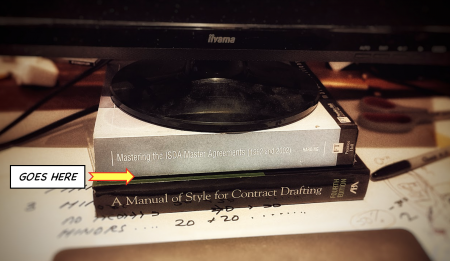Guide to the legal profession
Those vanity-published annual guides to the profession are untterly invaluable to the modern practitioner, because they make excellent platforms for raising your monitor in the home office. They are sturdy, stable, stiff, give a good inch or so of clearance, and even competing market products (like the “Legal 500” or any of the Chambers Global Practice Guides) are fully stackable, interoperable, and backwards-compatible.
|
Office anthropology™

|
As a monitor support, a legal almanac scores over the traditional ream of A4 printer paper in one important regard: durability. Because there is no other practical use for a guide to the legal profession, you may safely stuff two or three of them under your screen indefinitely without fear of having to disassemble your workstation because you have an urgent job and the last sod who used the printer didn’t restock the paper supply in the cupboard.
Recent times have nonetheless been tough for publishers of legal almanacs. They have been hit by a triple cocktail of woe:
Critical theory got ... critical
In 2019, from nowhere, almanac publishers were forced into panicky defensive virtue-signalling when their “rigorous selection methodology” — largely “recommending your buddies as a prank and then voting for each other” — was found to be doctrinally wanting by humourless critical legal theorists.[1] The publishers’ response, though reasonable —“wait a minute? I don’t think anyone actually reads these guides, do they? Doesn’t everyone just use them to prop up their monitors?” — fell on deaf ears.
But almanac publishers are nothing if not resourceful: there is now a “Chambers Diversity & Inclusion” guide to the exclusive intersectionally marginised global elite.[2]
Covid goes virtual
But alas it didn’t stop there. The Covid pandemic prompted the move of much of the legal almanac publishing industry to digital, thereby making the same category error the critical theorists did, which was to assume that people acquire guides to the legal profession because they want to read them. But as we know, they do not. People like legal almanacs to prop up their monitors, hold fire-stop doors open, and sandwich between pot plants around the department to make the place look bookish. An e-version of a legal almanac no good for that, unless you print it out, in which case you are better just to use a ream of virgin A4 paper, as you can at least use that if need be if you otherwise run out.
Printing is so 2019
Covid is a double crisis, too, because no-one prints any more, so a ream of A4 is now a fairly safe bet.
See also
References
- ↑ Or possibly practitioners, posing as humourless critical legal theorists, who were disappointed not to have been included.
- ↑ https://diversity.chambers.com/ “Diversity and inclusion is at the very heart of what we do and who we all are. We are all, in that regard, fundamentally the same, yet at the same time we screen our people to make sure D&I is a fundamental part of our DNA.”